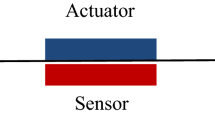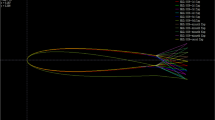Abstract
In this paper, the effect of using a piezoelectric material has been shown on postponing the flutter phenomenon on a regular blade. System response of a smart blade with only flap-wise and edgewise plunge DOF shows that the oscillations of the smart blade can be effectively decayed in a very short time using efficient piezopatches in the flap-wise and edgewise plunge DOF. Furthermore, in a smart blade with four DOF, it has been indicated having piezopatches in flap-wise and edgewise plunge DOF can defer the flutter speed 81.41% which is a noticeable increase in the flutter speed. Finally, by adding a piezopatch to the pitch DOF to a smart blade, it is possible to postpone the flutter speed 155% which is a very considerable increase.
















Similar content being viewed by others
Data availability
I confirm that my data are not in repository, include hyperlinks and persistent identifiers for the data where available. My data can be shared openly.
References
Nguyen NT, Ting E, Lebofsky S (2015) Aeroelastic analysis of a flexible wing wind tunnel model with variable camber continuous trailing edge flap design. Amer Institf Aeron Astron 11:2015–1405
Hallissy BP, Cesnik CES (2011) High-fidelity aeroelastic analysis of very flexible aircraft AIAA. Amer Instit Aeronaut Astronaut. 22:2011–1914
Bisplinghoff RL, Ashley H, Halfman RL et al (1996) Aeroelasticity. Republication; Dover Publications; New York, USA
Fung YC (2008) An Introduction to the Theory of Aeroelasticity. Republication; Dover Publications; New York, USA
Dowell EH (2015) A Modern Course in Aeroelasticity, 5th edn. Springer International Publishing, Switzerland
Hodges, D.H.; Pierce, G.A. 2011 Introduction to Structural Dynamics and Aeroelasticity, 2nd eds Cambridge University Press. USA
Wright JR, Cooper JE (2015) Introduction to Aircraft Aeroelasticity and Loads, 2nd edn. John Wiley & Sons, Ltd., USA
Moosavi R, Elasha F (2022) Smart wing flutter suppression. Designs 6(2):29
Verstraelen, E.; Gaëtan, K.; Grigorios, D. 2017 Flutter and Limit Cycle Oscillation Suppression Using Linear and Nonlinear Tuned Vibration Absorbers. In Proceedings of the SEM IMAC XXXV
Rocha J, Moniz PA, Costa AP, Suleman A (2005) On active aeroelastic control of an adaptive wing using piezoelectric actuators. J Aircr 42:278–282
Olympio KR, Poulin-Vittrant G (2011) A Honeycomb-Based Piezoelectric Actuator for a Flapping Wing MAV; SPIE Smart Structures and Materials, Nondestructive Evaluation and Health Monitoring: San Diego. CA, USA
Kucuk I, Yıldırım K, Adali S (2015) Optimal piezoelectric control of a plate subject to time-dependent boundary moments and forcing function for vibration damping. Comput Math Appl 69:291–303
Kuriakose VM, Sreehari V (2021) Study on passive flutter control of damaged composite laminates with piezoelectric patches employing finite element method. Compos Struct 269:114021
Bahaadini R, Saidi AR, Majidi-Mozafari K (2019) Aeroelastic Flutter Analysis of Thick Porous Plates in Supersonic Flow. Int J Appl Mech 11:1950
Muc A, Flis J, Augustyn M (2019) Optimal design of plated/shell structures under flutter constraints—a literature review. Materials 12:4215
Lossouarn B, Aucejo M, Deü J-F, Multon B (2017) Design of inductors with high inductance values for resonant piezoelectric damping. Sens Actuators A Phys 259:68–76
Dimitriadis G (2017) Introduction to Nonlinear Aeroelasticity. Wiely, USA
Theodorsen T (1934) General theory of aerodynamic instability and the mechanism of flutter. NASA Ames Res Cent Clas Aerodyn. 1934:291–311
Lee B, Price S, Wong Y (1999) Nonlinear aeroelastic analysis of airfoils: bifurcation and chaos. Prog Aerosp Sci 35:205–334
Lee B, Gong L, Wong Y (1997) Analysis and computation of nonlinear dynamic response of a two-degree of freedom system and its application in aeroelasticity. J Fluids Struct 11:225–246
Acknowledgements
This research received no specific grant from any funding agency in the public, commercial, or not-for-profit sectors.
Author information
Authors and Affiliations
Corresponding author
Ethics declarations
Conflict of interest
The authors declare no conflict of interest in preparing this article.
Additional information
Publisher's Note
Springer Nature remains neutral with regard to jurisdictional claims in published maps and institutional affiliations.
Rights and permissions
About this article
Cite this article
Moosavi, R. Smart blade flutter alleviation. Engineering with Computers 39, 3865–3876 (2023). https://doi.org/10.1007/s00366-023-01832-9
Received:
Accepted:
Published:
Issue Date:
DOI: https://doi.org/10.1007/s00366-023-01832-9




